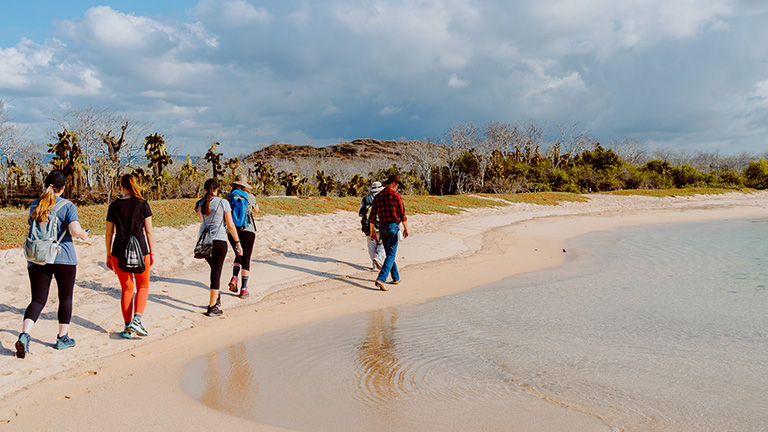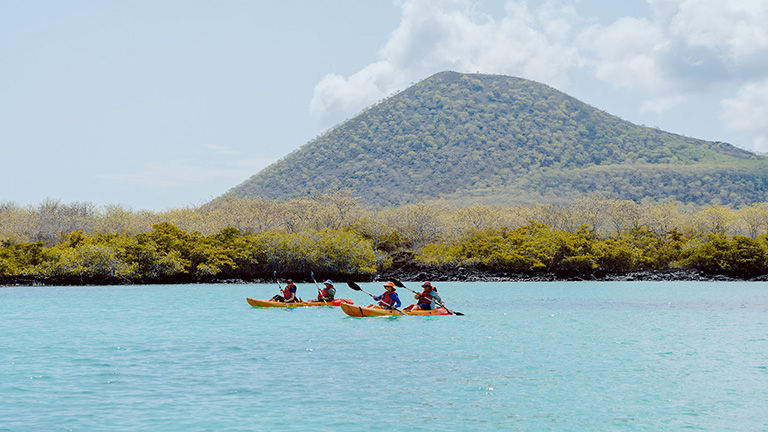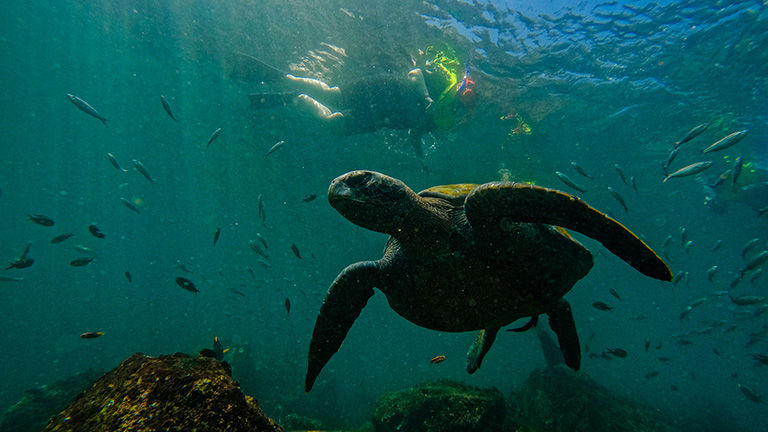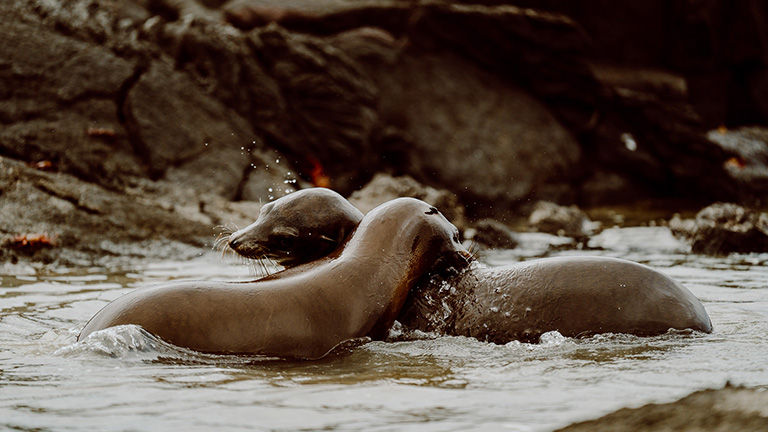If you only know one thing about the Galapagos Islands, it’s probably wildlife-related. Either you know the legacy of Charles Darwin’s research, or the fact that the destination is a pristine refuge for a slew of unique species.
But on my first-ever visit to the Galapagos last month with Hurtigruten Expeditions, I was struck by something else: how tightly controlled and highly regulated the destination’s tourism industry is — and how much that benefits the preservation of this wild land.
The magic of a Galapagos visit is exploring untouched landscapes, enjoying up-close viewings of species found nowhere else on the planet, and hardly ever encountering people outside your immediate travel group. But, as many places around the world have learned, it’s not that easy to balance the demands of tourism with the protection of a destination and its locals (be they animal or human).
So, how does the Galapagos provide visitors with the experience of a lifetime in a sustainable, responsible way?
Operating Rules in the Galapagos
Among the rules established by the Galapagos National Park Directorate (GNPD) is that travelers can only visit protected areas of Galapagos National Park (which comprises 97% of the land surface of the Galapagos) with an authorized tour operator and/or boat. Even beyond that, visitors must be accompanied at all times by a naturalist guide authorized by the GNPD. In a nutshell: Every company operating in the Galapagos follows a strict set of rules, and no traveler can explore without supervision.
It’s hard to walk away from an inquisitive baby sea lion who wants to play, but these rules are in place to protect the animals.
In order to become a naturalist guide, you have to either be born in the Galapagos or married to someone from the Galapagos, according to Ramiro Tomala, a Hurtigruten Expeditions guide, who adds that training from the national park is then required. Aside from protecting the environment, these rules benefit the local community, as well, ensuring residents receive a piece of the tourism pie.
 Travelers must be accompanied by an authorized guide at all times.
Travelers must be accompanied by an authorized guide at all times.
Credit: 2023 Hurtigruten ExpeditionsIn Hurtigruten Expeditions’ case, the line partners with Ecuadorian operator Metropolitan Touring, a pioneer in Galapagos tourism in which Hurtigruten now owns a minority stake.
“It was important for us to work with a local partner that is as committed to sustainable tourism as we are,” said Karin Strand, vice president of expeditions at Hurtigruten Expeditions. “Hurtigruten Expeditions pioneered expedition cruises in 1896, and Metropolitan Touring pioneered expedition cruises in the Galapagos almost 70 years ago — we share a common heritage.”
Visitor Numbers and Distribution
To further control tourism, there’s a limit to how many visitors can enter the national park at any given time.
“Guests can only enter the designated national park area on one of 69 boats and [11] certified day cruises,” Hurtigruten's Strand said. “Occupancy-wise, that comes to 1,660 people on boats and 180 people on day-cruises, per day.”
Strand further notes that ship capacity cannot exceed 100 passengers. These restrictions are all key to protecting the destination, she says, especially because it has seen aggressive growth over the last decade — since 2010, arrivals have increased by 56%, from roughly 173,000 to 271,000 visitors.
In addition to controlling the number of visitors to the national park, the GNPD ensures tourists are spread around the islands. According to Strand, a permit system allocates time slots to one operator at a time for each visitor site.
 Thanks to a system of allocated time slots at visitor sites, travelers will feel like they have each destination all to themselves.
Thanks to a system of allocated time slots at visitor sites, travelers will feel like they have each destination all to themselves.
Credit: 2023 Hurtigruten ExpeditionsTravelers benefit from this system, too, as they basically have the destination to themselves each time they go onshore. During my trip, our ship was usually the only one in sight, and our group was always the only one on land, which provided us unobstructed access to every animal encounter, scenic vista and photo op along the way.
Rules for Visitors in the Galapagos
Companies aren’t the only ones responsible for preserving the Galapagos Islands — there are also rules for travelers.
For one, visitors must not introduce any foods, animals or plants that could threaten the environment as an invasive species. To this end, all luggage is inspected upon arrival. Travelers are additionally forbidden from taking home any “natural souvenirs” (so, no shell-collecting on these beaches).
 Travelers must stay 6 feet away from wildlife, but still enjoy up-close views of animals.
Travelers must stay 6 feet away from wildlife, but still enjoy up-close views of animals.
Credit: 2023 Hurtigruten Expeditions“As we explain to guests, the only things you can take home from the Galapagos are memories,” Strand said.
As we explain to guests, the only things you can take home from the Galapagos are memories.
Other important rules include staying on marked trails, not feeding the animals and maintaining a safe distance from wildlife — in fact, a major reason an authorized guide must be present at all times is to enforce these guidelines for visitors.
“Proximity to wildlife is one of the destination’s most captivating elements, but we must respect the animals by keeping our distance,” Strand explained. “Because the animals aren’t afraid of us, they don’t run away; they’re often curious. It’s hard to walk away from an inquisitive baby sea lion who wants to play, but these rules are in place to protect the animals.”
Honestly, travelers will hardly notice these rules even as they follow them. The required distance of 6 feet from wildlife feels like nothing when you’re practically face-to-face with a giant tortoise or swimming alongside a sea turtle.
 Clients in the Galapagos might get to see unique animal behaviors, such as sea lions play-fighting.
Clients in the Galapagos might get to see unique animal behaviors, such as sea lions play-fighting.
Credit: 2023 Hurtigruten ExpeditionsWhat’s more, these protections ensure that the local wildlife doesn’t feel threatened by any human presence — and makes them much more likely to go about their regular business. This means travelers get up-close access they’re not likely to find outside the Discovery Channel. During just four days in the Galapagos, I saw sea turtles mating, blue-footed boobies preening, sea lions play-fighting, marine iguanas swimming and so many other wild behaviors I’m unlikely to ever see anywhere else.
In the end, what’s most special about the Galapagos Islands is the way in which humans and nature are able to coexist so beautifully. It’s a lesson that other destinations would do well to follow.